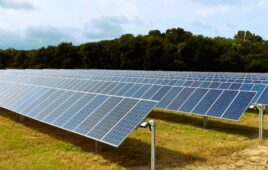By Dan Nordloh, executive vice president of EnSync Energy
The solar ecosystem is a rapidly changing space. Until recently, the role of solar developers was akin to a train station operator anticipating train station traffic at a small-town stop. The inputs and drivers of standalone solar were simpler. However, the integration of storage and other distributed energy resources into the energy landscape is transforming the solar developer’s role into something more like orchestrating train traffic at Grand Central Station in New York City, with many more trains and other forms of transportation arriving and leaving the hub.
To capitalize on these burgeoning markets, solar developers need to include more multi-dimensional thinking into their projects. Research is crucial for analyzing the new inputs and outputs and assessing the viability of solar+storage projects. This article offers three steps for the planning stages of integrating storage into solar solutions across market analysis, technical design and financial performance.
- Understand the markets
Solar+storage developers need good energy policy awareness to map out potential value streams and find strong target customers. This market research fuels evaluations on how much revenue the projects will generate. EPCs and developers should devote resources to understanding these programs to hone in on ideal markets for solar+storage projects.
Developers should start at a high level and understand what incentives are available from the federal government and then at the state level. For example, the National Renewable Energy Laboratory offers a brief breakdown of how the federal solar Investment Tax Credit can apply to solar+storage projects. Other resources dive deeper into geographies, including the Department of Energy-funded DSIRE’s database of incentives and policies for renewables and energy efficiency that is searchable by state.
The next step is understanding utility territories. Utilities are developing cutting-edge programs and solar+storage projects may interact with available applications. Solar+storage developers will need to understand simpler inputs like rate structures, demand charges, export limitations and energy shifting, along with more complex inputs like time-of-use rates, backup power, demand response and other utility incentive participation options.
In Hawaii, EnSync Energy and its local partners have boosted market policy research by regularly participating in the public utilities commission’s policy processes and directly engaging with the utility. With a higher level of insight, companies can even future-proof a project by factoring in a soon-to-be-developed incentive program, like a new demand response program, into its modeling. For more hands-on support, states with supportive policies often provide free technical support. For example, New York Battery & Energy Storage Technology Consortium (NY-BEST) offers developers free policy education and modeling support.
Equipped with key market inputs, a strong target customer will begin to emerge. The next step is to move into technical modeling and design characteristics.
- Match the project design to the market
Here developers build project designs to perform best in a given market, which requires a flexible model that can handle rapid iterations. The solar+storage design process considers the size and shape of the customer load; various technology setups that toggle the amount of photovoltaics, the size of the battery and what is exported to the grid; and the system’s performance. Enabling specific energy applications is a critical part of design considerations. For example, this could include sizing the battery with enough capacity to not only serve the customer load and reduce demand charges but also offer grid support to qualify for demand response incentives.
Many incentive programs require the use of a battery, which means participating in multiple programs can create multiple demands on the same battery. This kind of situation requires building an optimization to decide the most valuable use-case in the event of a trade-off.
For example, a solar+storage system aimed at reducing demand charges requires a certain portion of the battery capacity. However, if that system is also enrolled in a demand response program, there may be a time when a demand response event calls on the battery to discharge while a peak usage time is also coming down the pike. Without a prioritization in place, the demand response call could deplete the battery to the point where it would not have capacity to shave the customer’s peak load, ultimately incurring a costly peak demand charge.
It may make more sense to emphasize one program over another or take a hybrid optimization approach. Understanding how it all works together in a technical sense fuels the financial modeling needed to demonstrate how to maximize value.
- Speak to the achievable financial value
The financial output, though listed here last, drives both the market understanding and project design, as the system logic is continually optimized throughout the project development process.
The financial model connects the value creation and the cost to arrive at a cost-benefit analysis, expressed as return on investment, simple payback or internal rate of return. With each design configuration, assess how different levels of photovoltaics and storage interplay with costs and incentives and determine whether the resulting value is more or less relative to the increased investment. Identify the design that maximizes value within tax credit constraints and other benefit criteria, which circles back to the first step of “understand the markets.”
Tightly integrating financial performance into the entire process gives developers a greater assurance on the project’s ability to perform. Successful financial modeling allows a developer to go to the bank and show: “these are the value streams and here’s why.” With newer markets like solar+storage, this is particularly important for investors or lenders to be willing to put money behind projects.
By incorporating these three steps within project planning—understand the markets, match the project to the market and speak to the value streams—solar+storage developers can be confident they are developing a system that will generate reliable, affordable power and build their reputation among the new wave of customers hungry for solar+storage.






Tell Us What You Think!